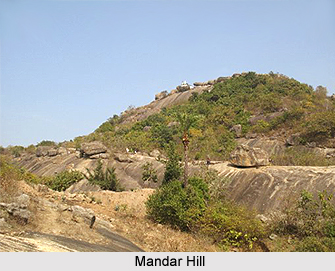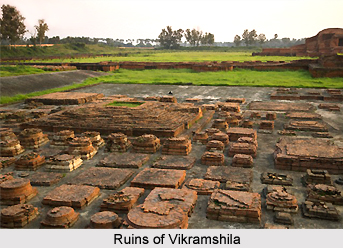 Mandar Hill in Bihar is about 700 feet high and is situated about 30 miles south of the town of Bhagalpur. Mandar Hill of Bihar consists of a huge mass of granite rocks overgrown near the summit with low tropical deciduous jungles. There are two temples near the top of the hill, approached by steps cut out of the rock. Mandar Hill is held very sacred in Hindu mythology and finds mention in the Mandar Mahatmya-a portion of Skanda Purana of Indian Puranas.
Mandar Hill in Bihar is about 700 feet high and is situated about 30 miles south of the town of Bhagalpur. Mandar Hill of Bihar consists of a huge mass of granite rocks overgrown near the summit with low tropical deciduous jungles. There are two temples near the top of the hill, approached by steps cut out of the rock. Mandar Hill is held very sacred in Hindu mythology and finds mention in the Mandar Mahatmya-a portion of Skanda Purana of Indian Puranas.
Early History of Mandar Hill
Bhagalpur district is a part of ancient Anga, one of the Sixteen Mahajapadas and is an area hoary with traditions and legends. Atharva Veda mentions the people of Anga. It is said that Titikshu, the second son of Mahamanas, the, seventh in descent from Anu, had founded the kingdom Anava and named it after its ancestors. The Asura king Bali had five Kshetraja sons from his wife Sudeshna, namely, Anga, Vanga, Kalinga, Pundra and Sumha. The Anava kingdom was extended under that Asura king and five kingdoms were carved out of it and named after his five sons. Later the Champa River separated it from Magadha. Anga comprised of the modern Bhagalpur District and Munger district. Malini was the capital of Anga at that time and later on, in Matsya Purana, it is mentioned that Champa Malini was the capital of Anga, where Mandar Hill is located now. There is frequent mention of the place in the Vana Parva of Mahabharata as a place of pilgrimage. The name of the state at that time was Champapuri. Champapuri is mentioned in the Mahabharata and later in the Buddhist literature. It has been a citadel of Buddhism as well as Hinduism.
Excavations near Mandar Hill
Near Mandar Hill, the Archaeological Survey of India discovered Buddhist relics. These relics indicate that Anga was very much under Buddhist influence. The area was also consecrated as the birthplace of Basupujya, the 12th Jaina Tirthankara and was closely associated with Parsvanath, the 23rd Jain Tirthankara. Lord Mahavira Vardhamana, the 24th and last Jaina Tirthankara, had spent three years at Champapuri.
 During the time of Lord Buddha, Champa was one of the six great cities, along with Rajagriha, Sravasti, Saketa, Kaushambi District Varanasi and Subhadrangi. The mother of Ashoka was born at Champa. This Mandar Hill is also associated with a number of Jataka stories.
During the time of Lord Buddha, Champa was one of the six great cities, along with Rajagriha, Sravasti, Saketa, Kaushambi District Varanasi and Subhadrangi. The mother of Ashoka was born at Champa. This Mandar Hill is also associated with a number of Jataka stories.
The numerous relies of buildings, tanks, large wells and stone figures, found for a mile or two round the base of this sacred bill, indicate that once there was a large city here. The popular story is that the city at the foot of the hill had fifty-two markets, fifty-three streets and eighty-eight tanks. According to local tradition, on the night of the Diwali festival, thousands of lights previously illuminated a large edifice each householder supplying one light only. The two places of worship at the top are to be approached by stages, as it were. At the foot of the hill, there is a tank called Papaharini and from the vicinity of the tank, three routes lead to the top of the hill.
As a Place of Pilgrimage
Mandar Hill is a great place of pilgrimage although it is not so well known now. The relies on Mandar Hill indicate a confluence of two religions, Hinduism and Jainism, and side by side there are temples held sacred by the followers of these two creeds. Kala Pahar desecrated Mandar Hill temples and one of the idols, Madhusudan Bhagwan, was removed by someone and enshrined in a temple at Baunsi. Especially on Makar Sankranti day thousands of local pilgrims visit the temples at Mandar, which are now in ruins.
Jain Temple at Mandar Hill
There is a beautiful Jain Mandar Hill Temple (Mandar Giri Digambar Jain Temple) decorated by glass work and sculpture in front of Mandar Hill railway station. This temple has high apexes and a coral-coloured idol of Lord Vasupoojya Swami, which is in cross-legged seating posture. Near Mandar Hill, there is a good-looking Mandar Hill Temple, which is a sole example of architectural art. It has an idol of white stone of Lord Vasupoojya Swami. At the salvation place on Mandar Hill, a grand Jain Mandar Hill Temple is erected. A pair of feet images (about 3000 years old) is installed there. There is a place where Lord Vasupoojya attained mystic acquaintance near the place of deliverance. Three pairs of ancient feet images are installed here. Near the place of salvation, a beautiful cave temple is viewable with 5-feet-tall standing idol.
Mandar hill is easily connected with the eastern railway line. It is connecting with the Bhagalpur with Mandar Hill. Mandar Hill station is about three miles from Mandar Hill. Also an all- weather road connects Bhagalpur with Dumka in Jharkhand. Mandar Hill is about a mile away from the road at a certain point.






